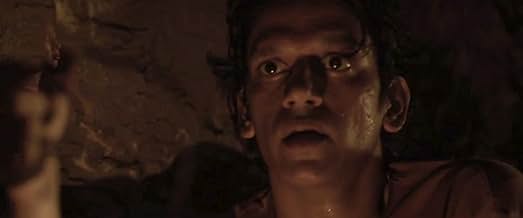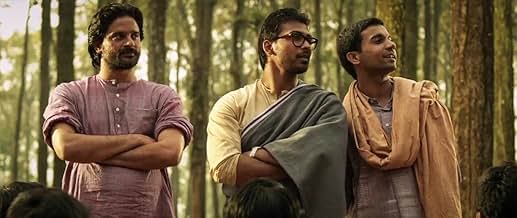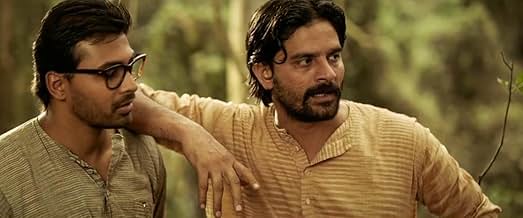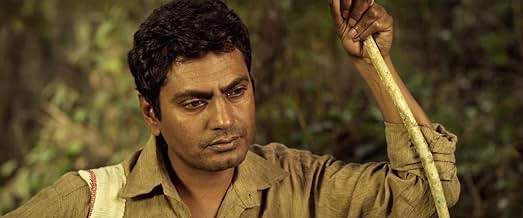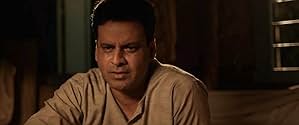IMDb-BEWERTUNG
7,3/10
1871
IHRE BEWERTUNG
Füge eine Handlung in deiner Sprache hinzuSchool kids organize an armed revolt in the 1930s in British occupied Chittagong. There are casualties on both sides. Later, one of those kids successfully leads the peasants to regain their... Alles lesenSchool kids organize an armed revolt in the 1930s in British occupied Chittagong. There are casualties on both sides. Later, one of those kids successfully leads the peasants to regain their food-grains earlier commandeered by the British.School kids organize an armed revolt in the 1930s in British occupied Chittagong. There are casualties on both sides. Later, one of those kids successfully leads the peasants to regain their food-grains earlier commandeered by the British.
- Regie
- Drehbuch
- Hauptbesetzung
- Auszeichnungen
- 4 wins total
Manoj Bajpayee
- Surya Sen
- (as Manoj Bajpai)
Rajkummar Rao
- Lokenath Bal
- (as Raj Kumar Yadav)
Arindol Bagchi
- Bhavani Lal
- (as Arindoi Bagchi)
Empfohlene Bewertungen
One of the most interesting things about Chittagong, the film, is that it is the debut feature of a 49 year old director with a PhD in physics, Bedabrata Pain, who left his day job as a leading scientist for JPL (Jet Propulsion Labs in Pasadena) after a brilliant 15 year career there, to take up a new career in filmmaking at the age of 45. He started out byco-producing a film by his Bengali wife Shonali Bose, "Amu" which dealt with the government backed pogroms against Sikhs in 1984 after President Indira Gandhi was assassinated by her own Sikh bodyguards. "Amu" was shown at major festivals such as Berlin and Toronto. Now Sinhali returns the compliment by coproducing Bedabrata's maiden effort along with maverick producer/director Anarug Kashyap of "Gangs of Wasseypur"
Pain's "Chittagong" is so well crafted that it's hard to believe this is a first time film by a new director, but there it is, one of the more topical films of the year. "Chittagong" tells the story of a little known uprising against British rule by Bengali shoolboys under the leadership of a charismatic village teacher, Masterda Surya Sen. Some audacious young ladies were also involved. Generally speaking historical films relating to partition have not fared well in India. Why such a tale is now suddenly of interest is a good question. Director Pain who is himself Bengali said that he wanted to tell a story in which the Indians come out victorious, because most historical films of the Raj colonial era tend to dwell on defeat and martyrdom. The schoolboy revolt succeeded and Chittagong was actually liberated in 1930, if only for a single day.
At the same time he said he did not want to give viewers a history lesson, but more a sense of dramatic entertainment. In this he has more or less succeeded. Chittagong has the right mix of all the elements --action, drama, politics, romance and patriotism, convincing little-known actors, and is also a history lesson, like it or not, maybe more so than intended.
Pain chose to shoot the film in Hindi, not the original Bengali language which was and is still spoken there. Chittagong today is not even in India, but in the Islamic state of Bangladesh next door, originally created as East Pakistan when India was partitioned in 1947. However, choosing Hindi, the language of Bollywood, automatically gives the film a national rather than a regional outreach. Several Bollywood character actors spotted by co-producer Anurag Kashyap, notably Manoj Bajpayee, who plays the teacher, Surya Sen, in Chittagong, and ended up as Boss Sardar Khan in Wasseypur I, and Nawazuddin Siddiqui who plays his military sidekick, Nirmal Sen, in Chittagong and his weed puffing son in Wasseypur II, have now become high profile figures in what is fast becoming an independent Bollywood Nouvelle Vague ...
Brash and ballsy Indian director-Producer Anurag Kashyap recently locked horns with Bollywood megastar Amitabh Bachchan on the widely read hotlines of personal media accusing Bachchan of using his industry clout to have the release of Pain's Chittagong delayed, so that another picture on the same subject starring Bachchan's own son, Abhishek, could get a leg up in the highly competitive B-Town market.
I needs to be mentioned that Abhishek Bachchan, 36 year old son of King Amitabh, while tall dark and handsome, is no chip off the old block as an actor, and has established a career as a leading man in Bollywood largely on the strength of his illustrious family name and his marriage to fabulous Bollywood beauty Aishwarya Rai.
The other Chittagong film in queston "Khelein Hum Jee Jaan Sey", (immediately dubbed KHJJS in true Bollywood fashion) is another Hindi period piece directed by Ashutosh Gowariker, starring Abhishek Bachchan and Deepika Padukone in the lead roles, and also based squarely on the same student uprising of 1930. Deepika, 26, is like Rai another striking beauty from the south, more lauded for her looks than her acting abilities, but exceptionally popular. Gowariker is a respected mainstream Bollywood director best known for "Lagaan" 2001, (Land Tax) which was barely nosed out for Best Foreign Film Oscar that year and brought some recognition to Bollywood from out west.
The two films were set for release around the same time but the Gowariker version got there first by a mile while the Pain pic was held up for over a year until now. Reacting sharply against what he saw as undue influence by Amitabh Bachchan to hold up release of Pain's Chittagong in order to protect his son's film from being upstaged, Kashyap started posting caustic remarks on the networking sites. One of them read: "See Chittagong, a far superior film made on the same subject as Khelein Hum Jee Jaan Sey.. At 1/8 th of the cost, far superior actors and immense passion... Producers decided to sit on it, because of a phone call from someone, because that someone was trying desperately to save his son's career... welcome to Bollywood, where whose son you are outshines all the hard work and passion and potential and talent. KHJJS came and went, now what?" Well, here's what. KHJJS received some respectable reviews but flopped badly in spite of it's prestige director and bankable stars. Chittagong was voted audience favorite in Florence, but it remains to be seen what it will do elsewhere, especially now that two of its actors, Siddiqui and Bajpayee, have become overnight sensations.
Pain's Chittagong was viewed at the River to River Indian Film Festival Florence,'Italy, in Dec. 2012
Pain's "Chittagong" is so well crafted that it's hard to believe this is a first time film by a new director, but there it is, one of the more topical films of the year. "Chittagong" tells the story of a little known uprising against British rule by Bengali shoolboys under the leadership of a charismatic village teacher, Masterda Surya Sen. Some audacious young ladies were also involved. Generally speaking historical films relating to partition have not fared well in India. Why such a tale is now suddenly of interest is a good question. Director Pain who is himself Bengali said that he wanted to tell a story in which the Indians come out victorious, because most historical films of the Raj colonial era tend to dwell on defeat and martyrdom. The schoolboy revolt succeeded and Chittagong was actually liberated in 1930, if only for a single day.
At the same time he said he did not want to give viewers a history lesson, but more a sense of dramatic entertainment. In this he has more or less succeeded. Chittagong has the right mix of all the elements --action, drama, politics, romance and patriotism, convincing little-known actors, and is also a history lesson, like it or not, maybe more so than intended.
Pain chose to shoot the film in Hindi, not the original Bengali language which was and is still spoken there. Chittagong today is not even in India, but in the Islamic state of Bangladesh next door, originally created as East Pakistan when India was partitioned in 1947. However, choosing Hindi, the language of Bollywood, automatically gives the film a national rather than a regional outreach. Several Bollywood character actors spotted by co-producer Anurag Kashyap, notably Manoj Bajpayee, who plays the teacher, Surya Sen, in Chittagong, and ended up as Boss Sardar Khan in Wasseypur I, and Nawazuddin Siddiqui who plays his military sidekick, Nirmal Sen, in Chittagong and his weed puffing son in Wasseypur II, have now become high profile figures in what is fast becoming an independent Bollywood Nouvelle Vague ...
Brash and ballsy Indian director-Producer Anurag Kashyap recently locked horns with Bollywood megastar Amitabh Bachchan on the widely read hotlines of personal media accusing Bachchan of using his industry clout to have the release of Pain's Chittagong delayed, so that another picture on the same subject starring Bachchan's own son, Abhishek, could get a leg up in the highly competitive B-Town market.
I needs to be mentioned that Abhishek Bachchan, 36 year old son of King Amitabh, while tall dark and handsome, is no chip off the old block as an actor, and has established a career as a leading man in Bollywood largely on the strength of his illustrious family name and his marriage to fabulous Bollywood beauty Aishwarya Rai.
The other Chittagong film in queston "Khelein Hum Jee Jaan Sey", (immediately dubbed KHJJS in true Bollywood fashion) is another Hindi period piece directed by Ashutosh Gowariker, starring Abhishek Bachchan and Deepika Padukone in the lead roles, and also based squarely on the same student uprising of 1930. Deepika, 26, is like Rai another striking beauty from the south, more lauded for her looks than her acting abilities, but exceptionally popular. Gowariker is a respected mainstream Bollywood director best known for "Lagaan" 2001, (Land Tax) which was barely nosed out for Best Foreign Film Oscar that year and brought some recognition to Bollywood from out west.
The two films were set for release around the same time but the Gowariker version got there first by a mile while the Pain pic was held up for over a year until now. Reacting sharply against what he saw as undue influence by Amitabh Bachchan to hold up release of Pain's Chittagong in order to protect his son's film from being upstaged, Kashyap started posting caustic remarks on the networking sites. One of them read: "See Chittagong, a far superior film made on the same subject as Khelein Hum Jee Jaan Sey.. At 1/8 th of the cost, far superior actors and immense passion... Producers decided to sit on it, because of a phone call from someone, because that someone was trying desperately to save his son's career... welcome to Bollywood, where whose son you are outshines all the hard work and passion and potential and talent. KHJJS came and went, now what?" Well, here's what. KHJJS received some respectable reviews but flopped badly in spite of it's prestige director and bankable stars. Chittagong was voted audience favorite in Florence, but it remains to be seen what it will do elsewhere, especially now that two of its actors, Siddiqui and Bajpayee, have become overnight sensations.
Pain's Chittagong was viewed at the River to River Indian Film Festival Florence,'Italy, in Dec. 2012
The movie narrates true events. It deals with the armed revolt in the 1930s, against the British rulers in Chittagong, executed by a master with the participation of school boys. Subsequently, there was also a peasant uprising in the same town, led by one of the school boys, against these British rulers.
The movie is not jerky, awkward, hurried or too slow.
However, it has taken up disproportionately more time in narrating the armed revolt and its aftermath; less time has been given to the later peasant uprising which happened in order to regain the food-grains forcibly commandeered by the Britishers.
This 'peaceful' peasant uprising was equally interesting and should have been detailed better. There are no scenes of how much has been commandeered by the British, what was the layout map of their location vis-a-vis the food-grains godown, how they planned the tunnel routes, how they planned the digging teams, how the teams actually dug the tunnels, the travails of digging the tunnels secretly, time frames involved, the general heroism of it all. The narrative was cursory here.
There was an immediate reason for the peasants to rise against the Britishers as their lands, crops and food-grains had been forcibly commandeered by them. However, it is not clear what particular events triggered the master in Chittagong to plan a revolt. The movie could have shed some light on that. If there were no particular events which triggered, then the movie could have explored how a widespread wave of resistance to the Britishers was building up in the entire country, and how the Chittagong folks were not unaffected.
Delzad Hiwale (as the young Jhunku) has acted very well. Nawazuddin Siddique, Manoj Bajpayee and Rajkummar Rao are well known actors and did well in this movie. However, a common observation for all these four actors (and particularly Manoj Bajpayee) is that their facial expressions were not so nuanced.
Vega Tamotia (as Pritilata Waddedar) acted well and also used facial expressions more.
All the actors in the movie have acted well. There was no amateurishness anywhere.
The good costumes did a lot in creating the period story effect in the movie. Apparently, a lot of care has been taken here. This whole thing was quite pleasing. Kudos to the Costume Designer Nilanjana Ghose.
The film location was apt, with the villages, the rural folk, the thick jungle, the rocky terrain, the single railway line and the deserted road lined with thick foliage.
This is a film production of high calibre, with good homework all around. The movie has mostly Indian actors and Indians in key non-acting roles. Only the Cinematographer and the Editor appear to be non-Indians.
It was a bit incredulous to see two bicycling policemen approaching the secret training ground inside the forest, where training to fire a rifle was being given to the school boys, and not hear the noise of the firing.
The music (songs) composing team of Shankar-Ehsan-Loy is quite popular in Bollywood. But, their extensive crooning in the background was inconsequential and jarring. This was a put-down and gave a Bollywood-like effect to an otherwise well crafted movie.
The movie is not jerky, awkward, hurried or too slow.
However, it has taken up disproportionately more time in narrating the armed revolt and its aftermath; less time has been given to the later peasant uprising which happened in order to regain the food-grains forcibly commandeered by the Britishers.
This 'peaceful' peasant uprising was equally interesting and should have been detailed better. There are no scenes of how much has been commandeered by the British, what was the layout map of their location vis-a-vis the food-grains godown, how they planned the tunnel routes, how they planned the digging teams, how the teams actually dug the tunnels, the travails of digging the tunnels secretly, time frames involved, the general heroism of it all. The narrative was cursory here.
There was an immediate reason for the peasants to rise against the Britishers as their lands, crops and food-grains had been forcibly commandeered by them. However, it is not clear what particular events triggered the master in Chittagong to plan a revolt. The movie could have shed some light on that. If there were no particular events which triggered, then the movie could have explored how a widespread wave of resistance to the Britishers was building up in the entire country, and how the Chittagong folks were not unaffected.
Delzad Hiwale (as the young Jhunku) has acted very well. Nawazuddin Siddique, Manoj Bajpayee and Rajkummar Rao are well known actors and did well in this movie. However, a common observation for all these four actors (and particularly Manoj Bajpayee) is that their facial expressions were not so nuanced.
Vega Tamotia (as Pritilata Waddedar) acted well and also used facial expressions more.
All the actors in the movie have acted well. There was no amateurishness anywhere.
The good costumes did a lot in creating the period story effect in the movie. Apparently, a lot of care has been taken here. This whole thing was quite pleasing. Kudos to the Costume Designer Nilanjana Ghose.
The film location was apt, with the villages, the rural folk, the thick jungle, the rocky terrain, the single railway line and the deserted road lined with thick foliage.
This is a film production of high calibre, with good homework all around. The movie has mostly Indian actors and Indians in key non-acting roles. Only the Cinematographer and the Editor appear to be non-Indians.
It was a bit incredulous to see two bicycling policemen approaching the secret training ground inside the forest, where training to fire a rifle was being given to the school boys, and not hear the noise of the firing.
The music (songs) composing team of Shankar-Ehsan-Loy is quite popular in Bollywood. But, their extensive crooning in the background was inconsequential and jarring. This was a put-down and gave a Bollywood-like effect to an otherwise well crafted movie.
I found this movie on Netflix under "Hidden Gems". Don't know if I would've ever come across it otherwise. The title immediately caught my attention of course. Chittagong is the second largest city of Bangladesh, my country of origin. Couldn't believe I hadn't heard of this film!
It turns out it is an Indian film. It was filmed in Hindi interestingly even though the historical figures featured in this film are Bengali. It would've been amazing had this been shot in Bangla, but I ask for too much. Although, while watching, I kept wondering why I don't know about this revolution or ever learned about these characters. It took me a long time to realize that I DID know! I just couldn't place the Hindi versions of the names! (For example the revolt was led by Surya Sen - but in Bengali we know him as Shurjo Shen.)
I don't know if this movie was dubbed and screened in Bangladesh or not. I hope it was. It is an important part of our history.
It turns out it is an Indian film. It was filmed in Hindi interestingly even though the historical figures featured in this film are Bengali. It would've been amazing had this been shot in Bangla, but I ask for too much. Although, while watching, I kept wondering why I don't know about this revolution or ever learned about these characters. It took me a long time to realize that I DID know! I just couldn't place the Hindi versions of the names! (For example the revolt was led by Surya Sen - but in Bengali we know him as Shurjo Shen.)
I don't know if this movie was dubbed and screened in Bangladesh or not. I hope it was. It is an important part of our history.
Almost nothing outrageous happens throughout the film.Even the armoury raid takes only about 10 minutes in the 105 minutes long film that too pre-interval.And thats the beauty of Chittagong, which depicts this forgotten tale (outside Bengal) so efficiently through silences,emotions and expressions.The honesty involved in making the film, touches you deep down and makes you forget the few flaws here and there.Manoj Bajpayee,Nawazuddin Siddiqui,Jaydeep Ahlawat,Raj Kumar Yadav all shine again after GOW and are aptly supported by Dibyendu Bhattacharya,Shaheb Bhattacharya,Anubrata and others.But its Delzad Hiwale as young Jhunku (loved him in Bubble Gum) and Vega Tamotia as Preetilata who stand out and make the deepest marks.Eric Zimmerman's camera is beautiful to say the least.Bedabrata Pain has really surprised with the maturity in execution,treatment and tight cholesterol free screenplay.Leaving apart the personal tragic story behind or his identity as a NASA scientist,Chittagong judged only in its own merit scores higher than most films on Indian freedom revolution.This definitely requires more screenings,viewings and word of the mouth publicity.
Yes... You can find him in this movie but main focus is on Jhunku.
So how call this movie as Chittagong I do not understand.
Wusstest du schon
- WissenswertesAt that time, Anurag Kashyap in a Facebook post had alleged that it was Amitabh Bachchan who stalled the release of Chittagong to save his son Abhishek Bachchan's career. He stated " See Chittagong, a far superior film made on the same subject as Khelein Hum Jee Jaan Sey.. At 1/8 th the cost, far superior actors and immense passion... Producers decided to sit on it, because of a phone call from someone, because that someone was trying desperately to save his son's career... welcome to Bollywood, where whose son you are outshines all the hard work and passion and potential and talent. KHJJS came and went, now what?".
Top-Auswahl
Melde dich zum Bewerten an und greife auf die Watchlist für personalisierte Empfehlungen zu.
- How long is Chittagong?Powered by Alexa
Details
- Erscheinungsdatum
- Herkunftsländer
- Offizieller Standort
- Sprachen
- Auch bekannt als
- Читтaгонг
- Drehorte
- Produktionsfirma
- Weitere beteiligte Unternehmen bei IMDbPro anzeigen
- Laufzeit1 Stunde 45 Minuten
- Farbe
Zu dieser Seite beitragen
Bearbeitung vorschlagen oder fehlenden Inhalt hinzufügen


